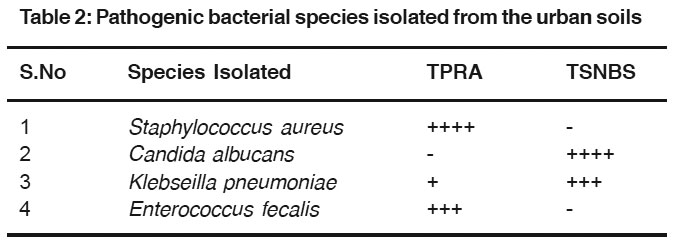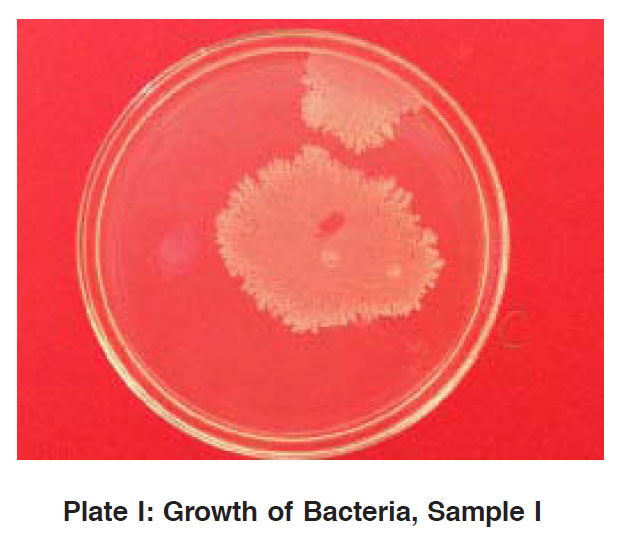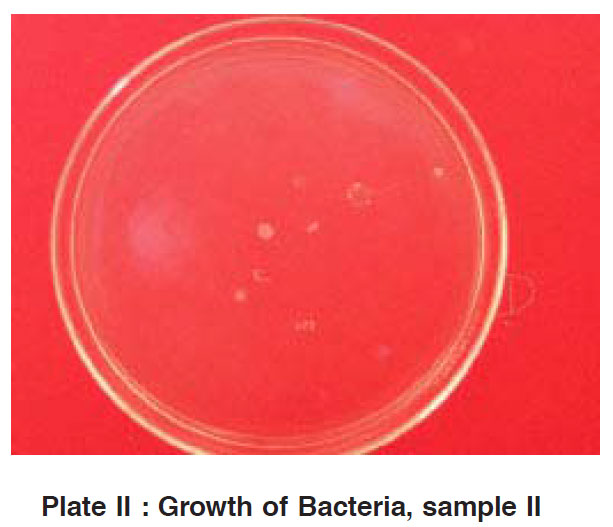A preliminary study of some physico-chemical and microbiological characteristics of a typical urban soil
Malika Pal1 * , Archana Lalwani1 and Raksha Chauhan1
DOI: http://dx.doi.org/10.12944/CWE.5.1.28
Surface soil are the weathered end products of various soil forming factors, which involve action of climate and living organisms on a specific soil parent material. Urban soils pollution and its effect or the characterization of an urban soil is yet to receive its due attention. The diffuse contamination has been revealed to be an important source for modification of the soil of the area.Contaminants reaching the soil disturbs its structure and modify its physico- chemical properties. They also affect the biological properties of the soil by modifying the microbial community and probably making a new or modified habitat.
Copy the following to cite this article:
Pal M, Lalwani A, Chauhan R. A preliminary study of some physico-chemical and microbiological characteristics of a typical urban soil. Curr World Environ 2010;5(1):169-172 DOI:http://dx.doi.org/10.12944/CWE.5.1.28
Copy the following to cite this URL:
Pal M, Lalwani A, Chauhan R. A preliminary study of some physico-chemical and microbiological characteristics of a typical urban soil. Curr World Environ 2010;5(1):169-172. Available from: http://www.cwejournal.org/?p=1140
Download article (pdf) Citation Manager Publish History
Select type of program for download
| Endnote EndNote format (Mac & Win) | |
| Reference Manager Ris format (Win only) | |
| Procite Ris format (Win only) | |
| Medlars Format | |
| RefWorks Format RefWorks format (Mac & Win) | |
| BibTex Format BibTex format (Mac & Win) |
Article Publishing History
| Received: | 2009-12-22 |
|---|---|
| Accepted: | 2010-01-28 |
Introduction
Soil is an organized mixture of organic matter, living organisms, air and water. Various types of soils are found in town and cities.1 Diffuse soil contamination has often been neglected in scientific literature, as most studies focus on contaminants from point-sources (either of industrial or agricultural origin). However, soil pollution from diffuse sources is recognized as one of the major soil threats. Deliberate disposal and spills from point sources have caused extremely high levels of pollutants in the soil at industrial sites , waste dumps so these have attracted more attention.2 Agricultural soils are also widely studied due to their direct economic impact.3,4,5
The urban soils are also important recipients of pollutants from a number of non point sources like road traffic, small scale industry, gas works, fires, house hold use of coal1,6,7 etc. The waste materials most frequently found in urban soils are associated with cycles of development, demolitions and redevelopment.1 It also receives organic wastes from stray animals and human population in habiting the area. Automobiles contribute 60 -70 % of pollution in urban environment.8 These produce volatile organic compounds , suspended particulate matter, oxides of sulphur ,carbon and nitrogen which have adverse effect on surrounding ecosystems.9
The present work was planned to study some of the physico-chemical and biological characteristics of soil laying on the edge of the road and from heavily populated area of Bairagarh a sub urban township of Bhopal, as there is an acute lack of baseline data on the physiochemical characteristics of a truly urban soil. Similarly we have enough data on the effect of automobile exhaust on road side plants (10, 11 &9) but its effect on soil microbes needs more attention.
Material and Methods
The soil samples (100-500g) were collected during field trip in Bairagarh in sterile Petri dishes and polythene bags to avoid external contamination, one (I) of the site was from a thickly populated residential area (TPRA) and other (II) was a traffic square near bus stand (TSNBS). The samples were collected from 6 inches from the soil surface, in order to avoid the contamination. The soils samples were air dried and grinded to pass through 2mm sieve. After drying and passing through the sieve the soil samples were analyzed for pH, Bulk density, Specific gravity, Nitrogen, Phosphorous, Potassium and Carbon - Nitrogen Ratio using standard analytical techniques.12-14
 |
Table 1: Physico-chemical and microbiological characteristics of the soil sample Click here to view table |
For the total bacterial count sterile NAM plates were inoculated with fresh soil samples of 10 -8 dilution in triplicate with spread plate method15 The plates were then incubated at 28°C±1°C for 48 hours for the growth of bacteria. Identification of pathogenic Bacteria was done using Hi Chrome UTI Agar Media and was tested using biochemical tests.16
 |
Table 2: Pathogenic bacterial species isolated from the urban soils Click here to view table |
Results and Discussion
The soil adjacent to road side with heavy vehicular traffic was heavier, denser (Table 1) and slightly more acidic than the soil sampled form the densely populated area. Out of the major nutrients present in soils i.e. NPK, the percentage of P and K were the same but nitrogen is significantly less in soil from densely populated site. The total nitrogen concentration of the soil from the site (I) is higher (Table 1) it could have been contributed by the mixture of automobile exhaust gasses it receives as the gaseous auto exhausts in the urban environment undergoes photochemical oxidation and forms variety of secondary compounds.17,18
 |
Plate I: Growth of Bacteria, Sample I Click here to view plate |
The acidic nature of the soil exposed to heavy vehicular traffic corresponds to the fact that automobile exhausts increase the acidity of the surfaces like leaves,10 buildings etc exposed to it.
 |
Plate II : Growth of Bacteria, sample II Click here to view plate |
The soil from densely populated area could be impregnated with construction wastes due to extensive construction which occurs in urban areas,12,6 which may explain its relatively high C- N ratio and low nitrogen content. The total bacterial count of this soil is also low as compared to the road side soil. More over microbial diversity may not correspond to the fertility status of the soil³. As soil exposed to different environmental conditions or exposed to different pollutants harbor different group of microbial community,6,2 with different growth characteristics as can be seen in plates I & II. Candida albucans Klebseilla pneumoniae are specifically present in the mucus membranes and its presence shows that the soil from site II is contaminated with human sputum. Presence of Staphylococcus aureus Enterococcus fecalis Klebseilla pneumoniae in both the samples (Table-II), indicate that they are contaminated with human & animal wastes and sputum.
The natural type of soil present in this part of central India is the medium light black soil also known as brown soil.20,21 But urban development severely changes the soil.¹ Since the sites are with in a narrow radius, it is expected that the soil must have been derived from same bed rock and are exposed to same basic climatic conditions .So what ever differences we got under different parameters must be due to human intervention only. From the results we can safely conclude that the anthropogenic activities play an important role in modifying the physical and biological attributes of the top soil and over the long period of time. The above preliminary study gives an insight to some of the characteristics of an urban soil but more study is required for the complete characterization of this man made micro habitat.
Acknowledgements
Authors are thankful to HOD Department of Botany and Biotechnology Sadhu Vaswani College and all technical and supporting staff for their support and encouragement and to UGC for providing financial assistance for the project.
References
1.Bridges, E.M., Soils in urban environment. P. Bullock and P. J. Gregory (Eds). Blackwell Scientific Publication.(1991) 28-36.
2.Rehman, M., Sharma, A., Dhagat, M., Indian J. Applied & Pure Bio. (2009) 24(2): 463-466.
3.Sharma. N., Sudarsan, Y., Sharma, R., Singh, G., Curr. Sci, (2008) 94(8): 25.
4.Kent A.D. and Triplett, E.W., Annu. Rev. Microbiol., (2002) 56: 211-236.
5.Tilak, K.V.B.R., Curr. Sci., (2005) 89: 136-150.
6.Ottesen.R.T., Alexander,J.,Langedal, M., Haugland, T., Hoygaard, E., Environ. Geochem. Health. DOI 10.1007/s10653-008-9181-x Springer Science + Business Media (2008).
7.Chen, T. B., Wong, J. W. C., Zhou, H.Y. and Wong, M. H., Environmental pollution, (1997) 96: 61-68.
8.Krishnayya, N.S. R., and Bedi, Environmental pollution (Series A) (1986) 40: 221-226.
9.Wagh, N.D., Shukla, P. V., Thambi, S. B. and Ingle, S.T. J. Env. Biol. (2006) 27(20): 419-421.
10.Chauhan, A. and Joshi, P.C., Eco. Env. & Cons. (2008)14(4).
11.Raina, A.K and Sharma, A. L.IJEP 23 (8), (2003) 897-902.
12.Murugesan, A. G. and Rajakumari, C. Environmental analysis and biotechnology, Theory and practice. M. J. P. Publishers Chennai. (2005) 243-310.
13. Gupta, A. Analytical chemistry. Pragti Prakashan. (2006) 160.
14. Jackson, M. L., Soil Chemical analysis. Prentice Hall of India Pvt. Ltd., New Delhi, (1973).
15. Seely, H.W.Jr., VanDemark, P., Microbes in action. A laboratory manual of Microbiology. Third Ed. (1981) 40.
16. Cappuccino J.C., Sherman N., Microbiology a laboratory manual. Pearson Education (Singapore). Pvt. Ltd. (2004)195.
17. Juszkiewicz. A., and Kijak, B. Polish Journal of Environmental Studies. (2003) 12(1): 49-56.
18. Jyothi, S. J. and Jaya, D. S., Eco. Env. & cons. 14(2-3): 347-356 (2008)
19. Kushwah, N. Malik, S. and Jain, P., Research link. (2009) 64(6): 12-13.
20. Anjaneyulu, Y., Land resources. Introduction to Environmental Science. (Ed). Rao, N., B. S. Publications, Hyderabad A.P. (2008) 209-226
21. Odum, E.P., Fundamentals of ecology. 3rd Edition. Natraj Pub. Dehradun. (1996) 106-139.







